
This guide is dedicated to inline figure skating wheels, a niche product in the vast world of inline skating, but rapidly growing among figure skating enthusiasts. The goal is to provide evaluation criteria that allow you to make a reasoned choice, to optimize the performance of your skates or, at least, to avoid making gross errors.
Inline figure skating is a fairly recent discipline, born from the idea of imitating the most widespread figure ice skating on a normal roller skating rink. This seems very interesting for various reasons:
- ice skating is very popular and attracts many young people, who often do not have access to an ice skating rink in their area, or have limited access only to certain times of the year.
- Ice skates perform better than quad skates, because the friction coefficient is lower (even though it is sliding friction!), Because they are lighter and because their moment of inertia is lower. Result: greater speed, greater rotation speed in jumps and spins, and - ultimately - greater spectacularity. Furthermore, with the ice skate it is possible to land from a jump on one of the lines (ie with the body tilted), which with the quad skate is almost impossible. This means faster learning and - ultimately - even more fun for the athletes.
- It is a discipline that -at the moment-, especially in the women's sector, is less "crowded" than the others.
- Both traditional artistic skaters and ice skaters can easily access this discipline.
However, being a relatively young discipline -albeit very promising- there are also some problems that must be taken into consideration:
- The availability of high-level equipment specifically designed for this discipline is relatively scarce compared to other specialties of figure skating.
- The number of coaches who are dedicating themselves to the discipline of inline art is, at the moment, quite small.
- Not all skate clubs offer inline figure skating courses.
However, the trend seems to be positive, and inline figure skating is spreading fast. The companies in the sector have obviously not been standing still and have developed interesting products: we are mainly talking about frames and wheels. Among them, the Roll Line wanted to place itself in a prominent position, creating a new product line expressly dedicated to this discipline. In this way, for example, the Linea frame of the Roll Line was born, with cutting-edge configurability features and a general quality in line (excuse the pun) with that of the other products offered by this manufacturer: absolutely top .
In particular, we want to focus on wheels developed specifically for frames such as the Linea, or the Mirage from Jackson Atom Skates, another product that will have a great impact in the sector, thanks to its exceptional quality/price ratio.
We will therefore address the analysis of the characteristics of inline figure skating wheels in general terms, considering four main factors:
- The diameter of the wheel.
- The hardness of the wheel.
- The material used.
- The profile of the wheel.
1. Diameter
It is a factor that has an important influence on the different characteristics of a wheel. In particular, apart from other conditions, larger wheels:- allow you to reach higher speeds.
- They reduce acceleration and agility.
- They allow you to more easily overcome small obstacles on the rink.
- They are more efficient and smooth in rolling.
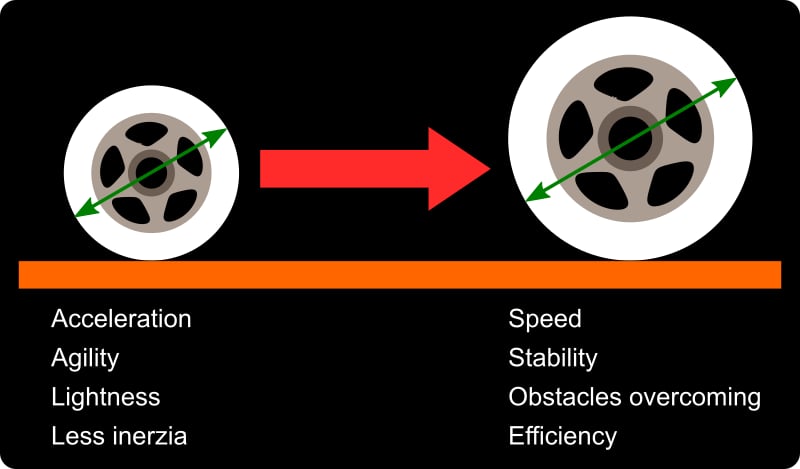
In the case of wheels for inline figure skating, it is assumed to operate on relatively smooth and clean surfaces, so that wheels with a particularly large diameter are not necessary. Indicatively, also depending on the characteristics and size of the frame used, the diameters range from 64 mm to 76 mm.
As far as the choice is concerned, we normally suggest to orient yourself towards the largest diameter that your frame is able to accommodate, usually smaller for children and greater for adults: this is because, with the increase in the technical rate, it is typically required greater speed and efficiency. In some cases, for example for the execution of programs in which the agility of the skate, the height of the jump and the rotation speed of the spins must be optimized, it is possible to opt for a reduction in the diameter of the wheels, which has as also effect the reduction of the weight and the moment of inertia of the skate. In any case, since skates for inline art are normally equipped with systems for defining/adjusting the rocker, generally all wheels of the same diameter are used.
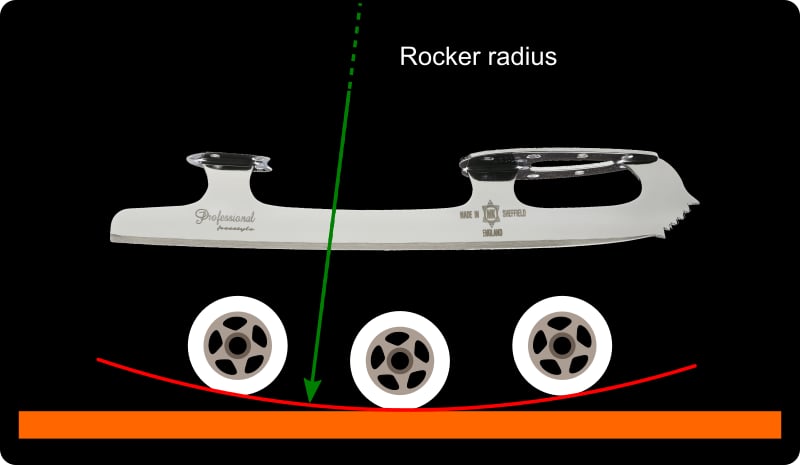
2. Hardness
The hardness of a wheel is a parameter that mainly determines two characteristics: grip and rolling resistance. It is difficult to find elastomers capable of exhibiting high hardness and high grip (intended as a static friction coefficient), usually these are antithetical characteristics. This does not mean that all materials exhibit the same behavior: for example, polyurethane elastomers exhibit, when dry, an excellent grip, with the same hardness, compared to other materials, such as natural rubber. Conversely, natural rubber outclasses them in the presence of water: this behavior, in reality, is not of great interest to us skaters, since training on a wet track is still not recommended.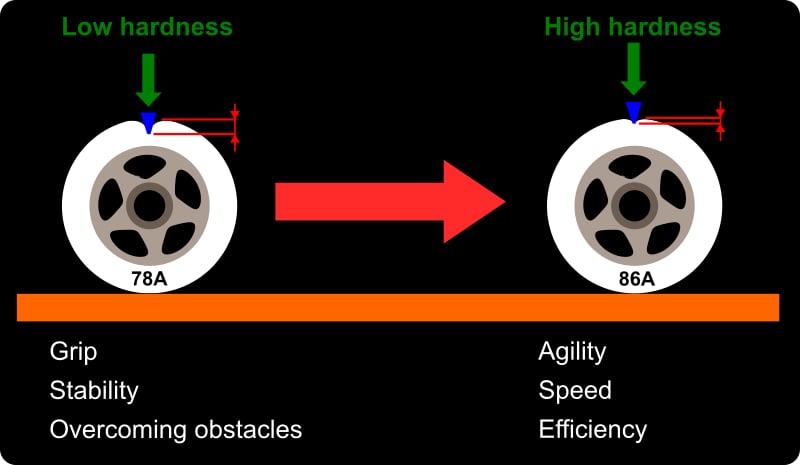
Rolling resistance is represented by the braking force that a skater perceives during movement, and is linked to many factors, mainly: type of bearings / lubricant, aerodynamic resistance and, above all, phenomena that occur in wheel-ground contact. In particular, the contributions that make up this last factor are mainly two:
- Effects inside the elastomer, which -by deforming- dissipates energy, transforming it into heat. This is something like a viscous friction inside the material.
- Differential sliding, given by the "flattening" effect of the wheel in contact with the ground, under the load constituted by the weight of the skater and his dynamic action. This effect mainly derives from the fact that, when the wheel "flattens", adhering to the track, for reasons of geometric compatibility it is necessary to slide between the elastomer and the track itself, during rolling, in points other than that corresponding to the circumference maximum. The following figure illustrates the origin of the phenomenon, which is not immediately understandable.
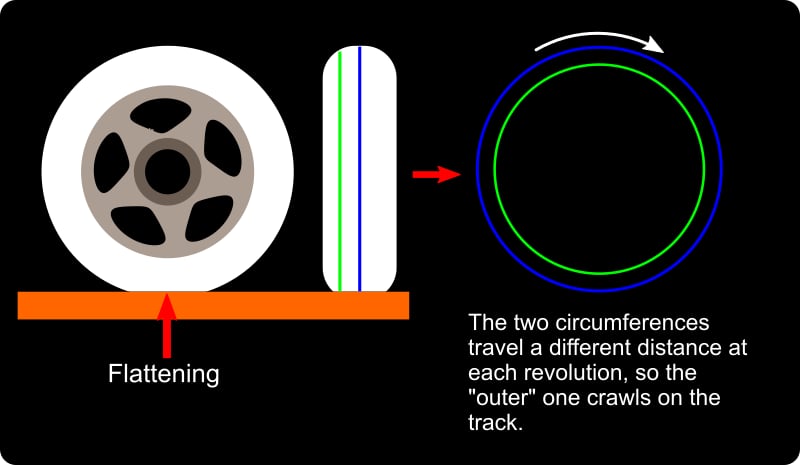
Both processes contribute to rolling resistance (the opposite of so-called "smoothness"), especially in wheels of lower hardness. Therefore, it is advisable to choose wheels with the maximum hardness compatible with the minimum grip that allows you to perform the foreseen difficulties with safety, depending on the surface of the track considered and the atmospheric conditions (humidity). This is not an easy choice: an experienced coach can certainly provide the right advice for the circumstances. However, it is necessary to have several sets of wheels available, and the necessary tools to replace them (quickly) should this become necessary.
One final note: harder wheels are also more durable, and this naturally goes toward money saving.
3. Material
The wheels for inline skating (artistic and otherwise) are produced almost exclusively using polyurethane elastomers. There are not many producers of these materials: they are mainly the large chemical multinationals. However, small producers can create elastomers with particular characteristics, suitably mixing different raw materials and modifying the process parameters. For this reason, even with the same hardness, the wheels produced by some companies are more smooth, or have a greater or lesser grip, etc.The formulations are naturally secret, and often derive from years of tests and modifications of the production "recipes": generally the best known brands offer products made with high quality materials. A somewhat rough way to evaluate the quality of an inline art wheel is to throw it in the air by rotating it around its axis and observing the height of the rebound from the initial altitude. This characteristic is generally referred to as "rebound" and is related to a characteristic of the elastomer that goes by the name of "resilience". Resilience above 80% are difficult to obtain, and indicate high quality wheels, very smooth and performing (for a certain hardness value). In particular, it is difficult to obtain wheels with high resilience if the hardness value is high.
4. Profile
It's one of the most important features, and countless posts have been written about it. The fact is this: on the one hand, a flat profile increases the agility of the wheel and reduces its efficiency, as mentioned in point 2. Furthermore, a flat profile does not allow the "edges" to be used effectively, for carrying out curved trajectories, preparation for jumps, landings, etc. Therefore, a curved profile is necessary, but those with too small radii, suitable for speed and distance skating, should be avoided, since also in this case edging, although possible, would not allow to make a curved trajectory efficiently.In essence, therefore, inline artistic wheels have an intermediate curvature, the result of a compromise. To test different types of curvature, all that remains is to buy wheels from different manufacturers and check which of them best meets Your needs.
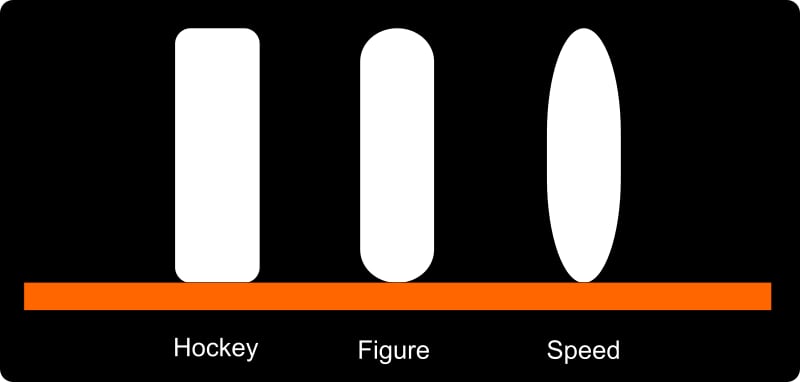
Conclusions
Choosing the perfect inline figure skating wheel for your characteristics and needs is quite complex. The advice of an expert is, as always, always an excellent solution: alternatively, you just have to arm yourself with patience and start trying, perhaps starting from the instructions we have given you.Have fun!
© GOinnova Srl 2018-2021
